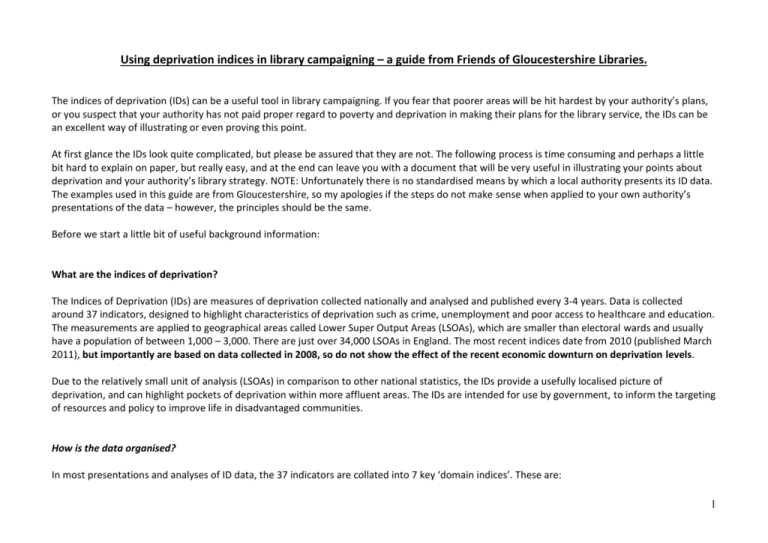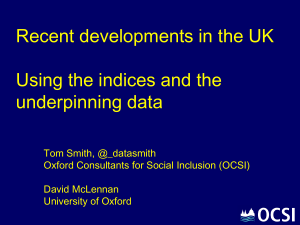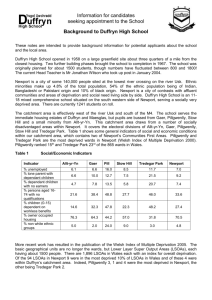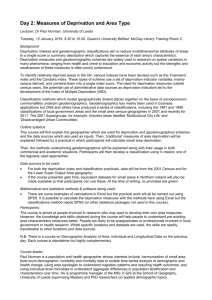Using deprivation indices
advertisement

Using deprivation indices in library campaigning – a guide from Friends of Gloucestershire Libraries. The indices of deprivation (IDs) can be a useful tool in library campaigning. If you fear that poorer areas will be hit hardest by your authority’s plans, or you suspect that your authority has not paid proper regard to poverty and deprivation in making their plans for the library service, the IDs can be an excellent way of illustrating or even proving this point. At first glance the IDs look quite complicated, but please be assured that they are not. The following process is time consuming and perhaps a little bit hard to explain on paper, but really easy, and at the end can leave you with a document that will be very useful in illustrating your points about deprivation and your authority’s library strategy. NOTE: Unfortunately there is no standardised means by which a local authority presents its ID data. The examples used in this guide are from Gloucestershire, so my apologies if the steps do not make sense when applied to your own authority’s presentations of the data – however, the principles should be the same. Before we start a little bit of useful background information: What are the indices of deprivation? The Indices of Deprivation (IDs) are measures of deprivation collected nationally and analysed and published every 3-4 years. Data is collected around 37 indicators, designed to highlight characteristics of deprivation such as crime, unemployment and poor access to healthcare and education. The measurements are applied to geographical areas called Lower Super Output Areas (LSOAs), which are smaller than electoral wards and usually have a population of between 1,000 – 3,000. There are just over 34,000 LSOAs in England. The most recent indices date from 2010 (published March 2011), but importantly are based on data collected in 2008, so do not show the effect of the recent economic downturn on deprivation levels. Due to the relatively small unit of analysis (LSOAs) in comparison to other national statistics, the IDs provide a usefully localised picture of deprivation, and can highlight pockets of deprivation within more affluent areas. The IDs are intended for use by government, to inform the targeting of resources and policy to improve life in disadvantaged communities. How is the data organised? In most presentations and analyses of ID data, the 37 indicators are collated into 7 key ‘domain indices’. These are: 1 1. 2. 3. 4. 5. 6. 7. income employment health and disability education, skills and training barriers to housing and services living environment crime These 7 domain indices are then combined to produce the Indices of Multiple Deprivation (IMDs) – a ‘headline measure’ commonly referred to in government reports, and used to provide a general indication of the deprivation level in an area. Two supplementary indices, deprivation affecting children and deprivation affecting older people are also sometimes included within this overall measure. Each LSOA receives a ‘score’ for each of the 7 domain indices listed above (or 9 if the 2 supplementary indices are included), as well as an ‘overall score’ using the IMDs. These scores are then ranked, with 1 = most deprived. Accessing the IDs. It is much better to access ID data from local authorities rather than from central government as it will be ready-sorted into the LSOAs that are of relevance to your campaign. All local authorities should make this data publicly viewable, and you should be able to find it by searching online for ‘indices of deprivation’ plus your authority’s name. When you find the right webpage (example) you should have the option to download a spreadsheet of data which will look something like Figure 1. The first four columns refer to the LSOA (which are identified first by a number code, then a name), next (third column) comes the ward within which the LSOA is situated, and (fourth column) the local authority area. The columns where colour has been added (this might not have been done in all cases – this is the Gloucestershire data and other authorities may present their data differently) are the indices themselves. Here, the first of these columns refers to the IMDs, the next seven are the individual domain indices listed above, and the remainder are supplementary indices (including the 2 mentioned above – deprivation affecting children and older people). 2 Figure 1 – Screen-grab of partial indices of deprivation data for Gloucestershire 3 Due to the small geographical size of LSOAs each authority contains hundred, and the spreadsheet will consequently have many rows. For instance, there are 367 LSOAs in Gloucestershire and as many rows in this spreadsheet. You will also notice that in the Gloucestershire example there are several sheets incorporated into this spreadsheet. We will look more at these during the analysis, but briefly, they show the county and national pictures of deprivation rankings, both in terms of actual rankings and quintiles (groupings of 20%). Analysing the data At this point it is useful to have beside you a list of the library branches you are concerned about and, if you’re not sure already, a map showing their location or a list of addresses. Indices of multiple deprivation – the county picture. First we are going to look at rankings within the authority area (in this example – the county of Gloucestershire), so we are working from the first spreadsheet sheet shown in Figure 1 – ‘COUNTY Ranks’. We are going to look for the top 10% and the top 10-20% of deprivation within the county based on the IMDs (the headline measure combining the 7 key domain indices). The statisticians at Gloucestershire County Council have helpfully highlighted the relevant cells in red (top 10%) and yellow (top 10-20%) so we can either scan down the list and pick out the right colours or, more easily, add a ‘filter’ to the column heading ‘IMD county rank’ and select ‘sort ascending’ (remember 1 = most deprived). In the Gloucestershire example, this obviously groups the red and then the yellow cells together at the tops of the list, as those LSOAs appearing in the top 10% and top 10-20% of deprivation will have the lowest IMD rankings and so worst deprivation. If your authority has not colour coded your data in this way, the same outcome can be achieved by looking at how many LSOAS there are in the county (look how many populated rows there are, then subtract the number used at the top of the spreadsheet for header rows). Then, follow the same ‘sort ascending procedure’ and count down and highlight 10% and then 20% of these rows. (E.g. in an authority with 300 LSOAs you would include the first 30 (top 10%) then the next 30 (top 10-20%). I found the easiest way to relate this to the libraries was to copy and paste the columns showing LSOA number, name, and IMD ranking to a new sheet while this filter was on. I did this for the LSOAs within the top 10%, and then for those within the top 10-20%, Giving me this (Figure 2): 4 Figure 2: Screen-grab of top 10% and top 10-20% most deprived LSOAs within Gloucestershire based on IMDs (partial) 5 You can then go through your lists, highlighting any where you know the library serving that LSOA faces cuts or closure (Figure 3): Figure 3: Screen-grab of top 10% and top 10-20% most deprived LSOAs within Gloucestershire based on IMDs with LSOAs affected by library cuts highlighted. 6 Note: There may be a smarter/quicker way of doing this without all the copying and pasting – if anyone finds it please let me know! Although most LSOAs are helpfully named so as to make it obvious where they are (name may correspond to ward name or recognised neighbourhood) others do not. The electoral ward may be helpful here, otherwise you can input the LSOA number (first column) here, and the LSOA will be shown on a map (select ‘Ordance Survey overlay’ to see village and town names). Domain indices – the county picture This process can then be repeated for each of the individual domain indices. If you like you can do all 7, but for my Gloucestershire report, as time was limited, I took 4 of the 7 key domain indices that appeared particularly pertinent to library use: 1. 2. 3. 4. Income Employment Education, training and skills Barriers to housing and services (includes transport links as indicator) As well as the two supplementary indicators - deprivation affecting children and deprivation affecting older people. Note: The indice ‘Barriers to housing and services’ was included as Gloucestershire is a large rural county, and poor public transport links have been identified by library users as a major barrier to many accessing the ‘new’ library service planned by GCC. For each indice, the same process as described above was repeated, but this time working from the column headed with the relevant indices name. e.g. ‘Income’ or ‘Employment’. Although this is quite time consuming, it is worth doing as even if an area does not appear in the top 10 or 20% of depirvation using the IMDs (which remember are a collation of all 7 key domain indices), it may appear in the top deprivation rankings for one or more of the individuals domain indices. A good example from the Gloucestershire data is the rankings for the domain indice ‘Barriers to housing and services’. None of the LSOAs that appear in the top 10 and 20% of deprivation for this indice feature in the top 10 or 20% for the other indices or the IMDs. In contrast to the other rankings, which are dominated by LSOAs within the county’s major urban areas of Gloucester and Cheltenham, the LSOAs which rank most derived 7 under this indice are dominated by rural areas of the Forest of Dean, Cotswolds and Stroud and Tewkesbury district. This allows us to make a useful argument about the impact that the closure of small rural branch libraries and the withdrawal of the mobile service will have on these kinds of areas. The national picture Some authorities also provide rankings based on the national indices (but not all). If your authority does, they will probably be included in the spreadsheet as a separate ‘sheet’ (as in the Gloucestershire example). You can switch to this sheet and repeat the processes outlined above to create a picture of where the LSOAs in your area affected by library cuts sit within the national picture of deprivation. The child well-being index Another dataset which may be useful – especially if you wish to illustrate the impact of library cuts and closures on children and young people – is the Child Well-Being Index. (CWI) Like the IDs, this is a small area index (using LSOAs), and is designed to measure deprivation exclusively as it impacts upon children. The CWI is a relatively new dataset (first published in 2009 using 2007 data) so may not be available from all local authorities yet. Like the IDs it is a ranking system applied to LSOAs, and follows similar methodology, comprising seven domain indices which can be analysed either independently, or in conjunction to arrive at an overall ranking. They are: 1. 2. 3. 4. 5. 6. 7. Material Well-being Health and Disability Education Crime Housing Environment Children in Need If the CWI data is available from your local authority, you will again probably be able to download a table which looks something like Figure 4: 8 Figure 4: Screen-grab of child well-being index data for Gloucestershire 9 This is quite similar to the IDs spreadsheet shown earlier, except the individual domain indices are shown on different sheets instead of within the same one. It is important to notice that in the CWI rankings, 1 = best (or least deprived) - the opposite to the IDs. I don’t know if this is typical or a peculiarity of the Gloucestershire data presentation, but always check the key or explanatory notes of any spreadsheet to avoid mishaps such as claiming the 10% least deprived areas are the most deprived! As I was short of time when conducting my ID analysis for Gloucestershire, I only looked at the overall CWI ranking, but you could also look at the individual indices as with the IDs. Again the Gloucestershire statisticians had made things easy by including the column ‘percent national’ which allowed me to identify the LSOAs within the top 10% and 10-20% very easily. To figure out the county rankings I simply sorted the data using the column ‘Rank of CWI’ - this time choosing ‘sort descending’ (with this presentation of the CWI, 1 = best/least deprived remember). I then copied and pasted the first 37 (10% of the LSOAs in Gloucestershire) into a new spreadsheet, followed by the next 37 to give me a list of the LSOAs ranked worst/most deprived in Gloucestershire using the CWI. This is exactly the same process as used for the IDs and detailed above, and was followed by the exact same process of highlighting those LSOAs where I knew the local library was affected by planned cuts or closure. Writing up your data. You should now have lots of excel spreadsheets (or sheets on the same spreadsheet depending on how you like to work). Each sheet should be titled with the name of the indice it refers to (IDM, name of the individual domain indice, CWI etc…) and whether the ranking you have copied and pasted refers to the national or county/local authority-wide picture. You now need to cross-reference your data to turn it into some kind of readable format. Initially keep the county/local authority-wide and national data separate. I found the easiest thing was to write a heading on a sheet of paper for each indice/multiple indice, (including whether the rankings you are referring to are local or national) with two columns – top 10% and top 10-20%. You can then go through your (already highlighted) spreadheets and list the LSOAs affected by library cuts/closures under the relevant heading. Then group these into one library-using ‘community’ (colour coding or highlighting may be useful here) to give yourself a definitive list of which planned library cuts or closures affect LSOAs which rank within the highest levels of deprivation based on each of the indices you have worked with. Do this for the IDMs, all the individual domain indices you have looked at, and the CWI (if you have used it), both locally and nationally. You can then use these lists to cross reference and write up your findings. I found it easiest to arrange my writing up by indice – starting first with the national 10 picture and then ‘zooming’ in on the local, but you can do this however you choose – some people may find it more suitable to organise their writing up by area/library for instance. Copeid below is my writing up of the findings for Gloucestershire (note, this report was prepared in February 2011, so uses the 2007 IDMs as the 2010 data was not released then). It is useful to add a couple of paragraphs of summary at the end too. I hope this guide has been some help to navigating the IDMs. If anyone finds a better/quicker method please let us know as this was arrived at by trial and error rather then any particular expertise. Again apologies if the vagaries of local authorities data presentation styles render any of this advice unhelpful. If you have any specific queries I will be happy to try and help (although please bear in mind that my and everyone else’s campaigning work at FoGL is voluntary and in their spare time). Please email FAO Demelza at foc.cheltlib@gmail.com 11 Indices of deprivation and GCC’s library strategy – a report by Demelza Jones for Friends of Gloucestershire Libraries. February 2011. Indices of Deprivation and Gloucestershire County Council’s library strategy. Under GCC’s plans for the library service, the public library service will be withdrawn from ten communities across the county. In these areas, a library will only remain in any form if it is run and largely funded by the community, and this ‘service’ will be cut off from the public library network. A further seven areas will see their service severely reduced to a ‘Library Link’, and the mobile library vans will disappear completely. Some of the areas affected by the plans are the most deprived in our county, as explored in this report using the Indices of Multiple Deprivation and the Child Well-being Index. 1. The Indices of Deprivation: The Indices of Deprivation are measures of deprivation collated by the Office for National Statistics. The measurements are applied to geographical areas called Lower Super Output Areas (LSOAs), which are smaller than electoral wards and usually have a population of between 1,000 – 3,000. There are just over 34,000 LSOAs in England, 367 of which are within the county of Gloucestershire. The Indices consist of seven ‘Domain Indices’: 1. 2. income employment 3. 4. 5. 6. 7. health and disability education, skills and training barriers to housing and services living environment crime 12 Using a range of indicators and data, each LSOA is awarded a ‘score’ per Domain, which allows it to be ranked relative to other LSOAs. These domain scores can be analysed in isolation, but are commonly combined to form the ‘headline measure’ – the ‘Indices of Multiple Deprivation’ (IMDs). Two supplementary Domains are also sometimes included; ‘income deprivation affecting children’ and ‘income deprivation affecting older people’. Rankings are arranged so that 1 = most deprived. The purpose of the Indices is to identify deprivation, and help government to target policies and funding in order to improve quality of life in disadvantaged communities. The most up-to-date Indices of Deprivation data dates from 2007. 2. Indices of Multiple Deprivation: Seven LSOAs in Gloucestershire rank within the top 10% most deprived areas of England, and a further eleven fall within the top 25% most deprived areas of England using the IMDs. This includes LSOAs in Matson and Robinswood, Hesters Way, St, Marks, Springbank and Tuffley. Under GCC’s plans, the libraries at Matson and Tuffley will be withdrawn, as well as Hesters Way Library which serves Hesters Way, St Mark’s and Springbank. LSOAs in these areas also fall within the top 10% of most deprived areas in the county. 3. Domain Indices: Six individual Domains have been selected for further attention. These Domains appear particularly pertinent to the role of libraries within communities; 1. 2. 3. Income Employment Education, training and skills 4. Income deprivation affecting children 13 5. 6. Income deprivation affecting older people. Barriers to housing and services (includes transport links as indicator) 3.1. Domain Indices – National Rankings: LSOAs within Gloucestershire appear in the rankings for the top 10% most deprived areas nationally based on each of the six Domains mentioned above. This is broken down by individual domain below, in relation to the areas that are having their public library service withdrawn under GCC’s plans. Income domain: Matson and Robinswood, Hesters Way, Springbank (served by Hesters Way Library) and Tuffley appear in the top 10% of deprivation nationally. Employment domain: Matson and Robinwood, Hesters Way and St Mark’s (served by Hesters Way Library) appear in the top 10% of deprivation nationally. Education, training and skills domain: Tuffley, Matson and Robinswood, and Springbank appear in the top 10% of deprivation nationally. Income deprivation affecting children domain: Matson and Robinswood, Hesters Way and Springbank appear in the top 10% of deprivation nationally. Income deprivation affecting older people: Springbank and Matson and Robinswood appear in the top 10% of deprivation nationally. While the story so far has been dominated by LSOAs within the county’s main urban areas, the rankings for the Domain ‘Barriers to Housing and Services’ paints a different picture. Thirty-one LSOAs within Gloucestershire rank within the top 10% of deprivation nationally, with the rankings this time dominated by LSOAs situated in rural areas, most often in the Forest of Dean and the Cotswolds, although Stroud and Tewkesbury districts are also represented. A key indicator within this Domain is ‘transport barriers’, so it is fair to assume that these rural areas score poorly in part due to 14 limited public transport links and the difficulties faced by those without access to a car -proportionally more likely to be the young, the elderly and the low-income. 3.2. Domain Indices – County Rankings: Income domain: Matson and Robinswood, Springbank, Hesters Way, Tuffley and St Marks appear within the top 10% most deprived areas in the county. Employment domain: Matson and Robinswood, St Marks, Hesters Way, Tuffley, Springbank, Newnham, Brockworth and Minchinhampton appear within the top 10% most deprived areas in the county. Education, training and skills domain: Tuffley, Matson and Robinswood, Springbank, Hesters Way, St Marks, Brockworth and Stonehouse (Library Link) appear within the top 10% most deprived areas in the county. Income deprivation affecting children domain: Matson and Robinswood, Hesters Way, Tuffley, Springbank, St Marks, Brockworth appear within the top 10% most deprived areas in the county. Income deprivation affecting older people: Springbank, Matson and Robinswood, Tuffley, St Marks and Stonehouse (Library Link) appear within the top 10% most deprived areas in the county. As with the national picture, the rankings for the Domain ‘Barriers to Housing and Services’ features rural areas. 4. Child Well-being Index: Starting in 2009, the Child Well-being Index represents the first attempt to create a small-area index exclusively for children in England. Like the IMDs it is a ranking system applied to LSOAs, and follows similar methodology. 15 Like the IMDs, the Child Well-being index comprises seven ‘Domain Indices’ which can be utilised both independently, or in conjunction to arrive at an overall ranking for a LSOA. They are: 1. 2. 3. 4. Material Well-being Health and Disability Education Crime 5. 6. 7. Housing Environment Children in Need Six Gloucestershire LSOAs fall within the top 10% of deprivation on the Child Well-being Index overall rankings nationally. A further thirty-one LSOAs fall within the top 25% nationally. This includes Matson and Robinswood, Tuffley, Hesters Way, Springbank, St Mark’s and Brockworth, all of whose libraries are earmarked for ‘community transfer’ under GCC’s plans. These same areas appear within the top 10% of deprivation county-wide. 5. Summary: It is plain that the new library strategy for Gloucestershire will seriously affect the county’s most deprived areas. 5.1. Summary – The national picture: Under GCC’s plans, the public library service at Matson Library and Hesters Way Library will be withdrawn, and a library will only remain operational in any form if run and funded by the community (‘community transfer’). LSOAs currently served by these libraries (Matson and Robinswood for Matson Library, and Hesters Way, St Marks, and parts of Springbank and St Peters for Hesters Way Library) appear in the rankings for the 10% most deprived areas nationally using the IMDs. Several more LSOAs in these areas feature within the top 25% nationally, as well as an LSOA within Tuffley, whose library is also destined for ‘community transfer. 16 LSOAs within areas currently served by Matson and Hesters Way Libraries appear in the top 10% most deprived areas nationally when using the individual Domain Indices of income, employment, education , training and skills, income deprivation affecting children, and income deprivation affecting the elderly. LSOAs within Tuffley also feature in the top 10% of deprivation nationally based on the Domains income, and education, training and skills. Matson and Robinswood features in the top 10% most deprived areas nationally using the Child Well-being Index, while LSOAs within the areas currently served by Hesters Way, Tuffley and Brockworth Libraries fall within the top 25% most deprived nationally. Thirty-one LSOAs within Gloucestershire rank within the top 10% of deprivation nationally based upon the Domain barriers to housing and service. These LSOAs are situated in rural areas. 5.2. Summary – The county picture Turning to the county rankings; using the overall Indices of Multiple Deprivation, LSOAs within the areas currently served by Matson, Hesters Way and Tuffley Libraries appear in the top 10% most deprived in the county of Gloucestershire, with an LSOA within Matson and Robinswood ranking as the 2nd most deprived area in the county. LSOAs within these areas also consistently appear in the top 10% ranking of most deprived areas in the county based on the following individual Domain Indices particularly relevant to library use; income, education, employment, deprivation affecting children, and deprivation affecting older people. Additionally, LSOAs currently served by Brockworth Library (‘community transfer’) feature on the top 10% most deprived rankings for the county when based upon the individual Domain Indices of employment, education, and deprivation affecting children. Stonehouse (destined for a ‘Library Link’) appears in the 10% most deprived ranking based on education, and deprivation affecting the elderly, and Newnham and Minchinhampton (both planned for ‘community transfer’) feature in the top 10% most deprived ranking based on employment. Areas currently served by Matson, Hesters Way, Tuffley and Brockworth Libraries also feature in the top 10% ranking of the most disadvantaged areas in the county using the Child Well-being Index. 17 Under GCC’s plans, all Gloucestershire communities where LSOAs register within the top 10% of deprivation at either the national or county level or both, based upon Indices of Deprivation, the five individual Domain Indices pertinent to library use, and the Child Well-being Index, and which currently have a public library service, will lose it. The top 10% ranking of deprivation based on the Domain, ‘barriers to housing and services’ is dominated by LSOAs located within our county’s rural areas, suggesting that poor rural transport links is an issue, and that the withdrawal or severe reduction of public library services in small rural towns and villages, plus the removal of the mobile library service, will also have a large impact. The Council’s own original Equality Impact Assessment, dated 9th November 2010, confirms that community needs and social impacts in deprived area have not been taken into account, by repeating the criteria of geographical spread and usage as the sole factors in decision making. A revised EIA was released in January 2011, and states that ‘Maiden (deprivation) data was analysed for each of the current libraries catchment areas with a note of any hotspots where the data significantly differed from the Gloucestershire norm. Areas where multiple deprivation indices applied were assessed’. Given the above information, it is difficult to see how this has been the case. It remains the case that the most deprived areas in Gloucestershire will lose their public library service under these plans. 18







